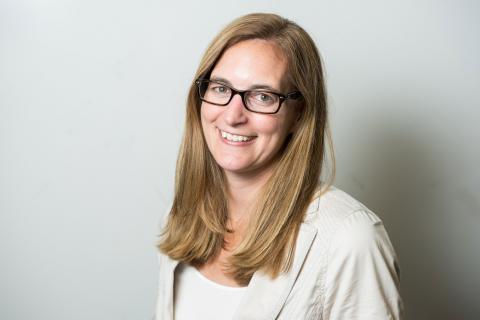New Designs for School
NGLC’s “Wait Wait…Don’t Tell Me"
Topics

We’ve all had the experience of truly purposeful, authentic learning and know how valuable it is. Educators are taking the best of what we know about learning, student support, effective instruction, and interpersonal skill-building to completely reimagine schools so that students experience that kind of purposeful learning all day, every day.
Real stories of launching and running personalized learning schools
Borrowing from the games of NPR’s radio quiz show, “Wait Wait…Don’t Tell Me,” four school leaders from the NGLC network share the hard-won lessons of launching, running, and evolving their blended, mastery-based, personalized learning schools.
This is a reprise of the original performance ‘broadcast’ live at the iNACOL 2014 Symposium in Palm Springs last week. Please welcome today’s guests:
- Judy Beard, from the southern state of South Carolina, principal of Horry County Schools’ Whittemore Park Middle School in Conway
- Oliver Sicat, CEO of Ednovate/USC Hybrid High in nearby Los Angeles
- Pamela Farris, all the way from the Motor City and Cornerstone Charter Schools
- Adam Carter, chief academic officer of Summit Public Schools in the heart of Silicon Valley
Your hosts today are NGLC’s Andy Calkins and Colorado Springs District 11’s Scott Fuller.
GAME #1: Who’s ‘Scott’ This Time?
(scroll to the end of this post for the answers)
“I waited 14 years to do something that I should have done my first year of teaching: shadow a student for a day. It was so eye-opening that I wish I could go back to every class of students I ever had right now and change a minimum of ten things—the layout, the lesson plan, the checks for understanding. Most of it!”
Our host, Andy, asked the guests, “How much are your schools student-driven?” Oliver estimated USC Hybrid High was 60% of the way to where they wanted to be. Pam said data was the driver of Cornerstone’s student-centered approach. Judy mentioned a “Student-Voice” team that they check in with once a week, and also told the crowd that students participate on the interview team when the school hires new teachers.
“In the US, ‘personalized learning’ is what I think of as a head-nodder phrase. Sprinkle the word into virtually any conversation or speech regarding education, and you’ll typically see at least a handful of heads nodding in the room in happy agreement. While some might view this as positive evidence for the merits of personalization, I suspect what’s really happening is that the idea is being treated as an empty vessel into which one may pour any number of competing theories of learning or favored education policies. A term that can mean anything often signifies nothing.”
Andy polled the guests for their opinion: Can students really set their own path?
Without hesitation, Adam replied, “Can kids direct their own learning? Yes. Absolutely.” Oliver and Pam both agreed, but added that they found that students needed structures and supports in place to help them do that—directing your own learning needs to be taught. After giving almost complete autonomy to USC Hybrid High’s students in the school’s first year, Oliver noted, most students were not making progress. So they changed strategy, started small, and built up from there: if students could choose their own path within one 75-minute block, then they could choose their own path in one week, building to one quarter, then half-a-year and so on.
“For free, for everyone, forever.”
“You want to change the world,” Andy said to the guests, “so what do you see changing?” Upon seeing the success of their model at Whittemore Park in just two quarters, Horry County Schools’ board voted to scale the model to all middle schools and then voted again to include all high schools in the district. “Students are driving that change throughout the district,” remarked Judy. For Pam it’s about seeing students actualize their goals and begin the journey of understanding who they are and what they need to do to be successful.
“Outside of a dog, a book is man’s best friend. Inside of a dog, it’s too dark to read.”
“Where is it too dark right now inside of your models?” our host asked the guests. Adam really wants to unlock the aspect of Summit’s model that supports habits of success, the non-cognitive skills complementing academic outcomes for students: “That’s what’s most exciting, to try to find a window into the habits of success.”
GAME #2: Limericks
Audience member Kathryn Kelly of ISchool, supplied the last word for three of the four guests’ limericks. To be fair, the correct answer for the fourth limerick involved two words, unfairly misleading Kathryn. But all four limericks gave the audience a view into the guests’ school experiences, like this one Judy read:
In the little South Carolina town called Conway
NGLC opened doors in a new way
Digital content arrived
Student engagement thrived
And the teachers all shouted _________
Judy advised the audience to never underestimate or overlook professional development and support for teachers. Drawing on her experience of converting a failing school to a personalized learning model, Judy said, “This is a scary proposition for teachers, especially for veteran teachers who have had successful records, to step out and try this.”
GAME #3: Bluff the Listener
Although all of the guests shared incredulous stories about their schools, only one of the guests shared a story that was not entirely true.
Pam said they had to put the three grades of their high school into three different school buildings when the construction company renovating their new facility dissolved over the summer and the building wasn’t ready as promised. In truth, the construction company did dissolve, and the school didn’t open on time, but the delay lasted only a month. The students were able to start school in their new building, all grades together, at the same time as the rest of the schools in Detroit, but not earlier as they had originally set for their school calendar.
Be flexible was Pam’s advice.
GAME #4: Lightning Fill in the Hard-Won Lesson
In this last game of the session, the audience raised their own questions and topics for the guests to respond to:
“What do you do if a student isn’t logging in and doesn’t communicate?”
Set up your advisories so teachers can bring the data to the student and have an open conversation with that student.
“If you had a time machine…”
I wouldn’t have tried to put everything in place on day one. I would have focused on just a few key elements of the model.
New roles for teachers?
Since teachers are facilitators, engage teachers in the logic of the content. They can then be more prescriptive in how they guide students as students work through the content.
Parent communication?
Invite parents into your school, and let their child show them how they are learning.
The journeys of Whittemore Park, Cornerstone, USC Hybrid High, and Summit Denali—the educational homes for today’s guests—are shared in Lighting the Path to Personalized Learning: Inspiring Stories from Next Gen Schools, a new report which Getting Smart produced in partnership with NGLC. Dive deeper into what’s working in these schools and be even more inspired by these school leaders attempting to produce dramatically better results for students by fundamentally altering the student learning experience.
Thank you for participating in today’s show. Your prizes—insights gleaned from our guests blazing the trail in personalized learning—may have no cash value but are, instead, priceless.
Answers: Alexis Wiggins; Ben Riley; Sal Khan; Groucho Marx; Hooray!




